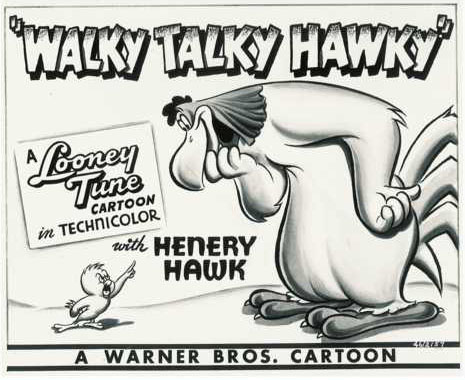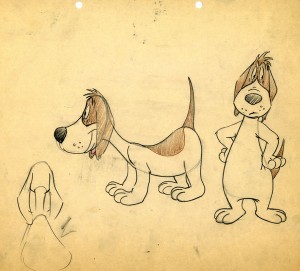
This month’s feature—AH SAY—this month’s feature is “Foghorn February” on Cartoon Research! Foghorn, that is…
Bob McKimson’s Walky Talky Hawky stars Henery Hawk, a small, pugnacious predator who first appeared in Chuck Jones’ The Squawkin’ Hawk, released in 1942. Henery hadn’t appeared in any other Warners cartoons until McKimson borrowed the character for this cartoon. The little chicken hawk appeared in featured stories for Dell’s Looney Tunes and Merrie Melodies Comics by late 1943, mainly drawn by Vive Risto, a former animator for Bob Clampett. Henery’s comic stories for LT&MM lasted until 1954, and continued in other series through the mid-‘60s. The original title sequences for Walky Talky Hawky are missing, therefore known copies are “Blue Ribbon” reissues; it’s certainly feasible that Henery Hawk received star billing in its original release, but this is only speculation until—or unless—a cutting continuity surfaces for this title (or by some miracle, a print with original titles surfaces).
 The story for Walky Talky Hawky, approved by late 1944, has Henery in search of his first chicken, and encountering a loud-mouthed barnyard rooster and a dog in the middle of their fraternal war. In developing the character, McKimson and story-man Warren Foster decided to base the rooster’s voice on a radio character, simply known as The Sheriff. Character actor Jack Clifford performed the deafened character on an early local variety show, Blue Monday Jamboree (1927-35), which McKimson remembered. Clifford’s mannerisms and voice served as an inspiration for the pompous rooster, particularly the Sheriff’s habit of restarting a sentence, prefaced with “I say…” McKimson wanted to use a different actor for the rooster instead of Mel Blanc, but was ultimately rejected; no surviving records indicate who the actor was. Here’s an example of Jack Clifford’s Sheriff from an early ‘30s episode of Komedy Kapers, courtesy of Keith Scott.
The story for Walky Talky Hawky, approved by late 1944, has Henery in search of his first chicken, and encountering a loud-mouthed barnyard rooster and a dog in the middle of their fraternal war. In developing the character, McKimson and story-man Warren Foster decided to base the rooster’s voice on a radio character, simply known as The Sheriff. Character actor Jack Clifford performed the deafened character on an early local variety show, Blue Monday Jamboree (1927-35), which McKimson remembered. Clifford’s mannerisms and voice served as an inspiration for the pompous rooster, particularly the Sheriff’s habit of restarting a sentence, prefaced with “I say…” McKimson wanted to use a different actor for the rooster instead of Mel Blanc, but was ultimately rejected; no surviving records indicate who the actor was. Here’s an example of Jack Clifford’s Sheriff from an early ‘30s episode of Komedy Kapers, courtesy of Keith Scott.
The character associated with the Foghorn Leghorn character is close, but isn’t fully realized; the rooster’s voice is quite gruff compared to his later cartoons. Contrary to popular belief, Senator Claghorn, performed by Kenny Delmar, couldn’t have influenced the voice for the rooster in Walky Talky Hawky. Keith Scott surmised the dialogue track was recorded on January 13, 1945, about nine months before his debut on Fred Allen’s radio show. Besides influences from radio comedy, former Disney effects animator Cornett Wood’s layouts for this cartoon helped establish the character’s presence; scene 33 of the rooster lying over a hilltop — animated by Dick Bickenbach — as he conspires with Henery, is another trait carried over to later entries (for example, 1950’s The Leghorn Blows at Midnight).
The delicate posing in McKimson’s layouts is strikingly evident in this, his fourth cartoon. Dick Bickenbach handles a marvelous sequence in scene 7, in which Henery’s father melodramatically lectures his son about a chicken hawk’s purpose in life — to crave and eat a chicken. Don William’s scene 12, as the rooster paddles the tethered hound, leading to a chase until he is stopped by the limit of his rope, established the premise in the rivalry between the dog and rooster, which continued throughout most of the series. This generated, arguably, some of the most brutal violence in Warners’ echelon of theatrical cartoons as the series progressed.Art Davis leaves a construction line in the middle of the rooster’s beak in his scenes; for instance, his first meeting with the naïve Henery as he convinces him that the dog is, indeed, a chicken. Scene 19, animated by Davis, expands upon Mel Blanc’s vocal performance as Henery (“Oooh, that’s the biggest chicken…ever I seed!”) with amusing results. Henery picking up the dog’s tail — in addition to reciting the slogan for Lucky Strike cigarettes — and biting down is also nicely done.
Released August 31, 1946, Walky Talky Hawky was nominated for an Academy Award, but lost to The Cat Concerto, with Tom and Jerry. As mentioned previously, this copy is a re-issued “Blue Ribbon” title. According to the original cue sheets, the song used under the opening titles was “Buzz Buzz Buzz (Will You Be My Honey?)” by Jimmie Lunceford, Alice Simms and Al Trace. Carl Stalling previously used the song under the opening titles for Bob Clampett’s Baby Bottleneck, released a few months earlier.
Hope you will all enjoy Foghorn February as much as I will! Enjoy, that is…



(Thanks to Michael Barrier, Keith Scott, Jerry Beck, Dave Gerstein, Andrew Gilmore and Paul Bussolini for their help.)



 DEVON BAXTER is a film restoration artist, video editor, and animation researcher/writer currently residing in Pennsylvania. He also hosts a
DEVON BAXTER is a film restoration artist, video editor, and animation researcher/writer currently residing in Pennsylvania. He also hosts a 




















































































Need to reupload on some other video player.
“Content Rejected
This video has been removed due to a breach of the Terms of Use” 🙁
I noticed that some Warner cartoons, such as “Walky Talky Hawky”, had at least two unique lobby cards. I wonder how many cartoons had this type of promotional material.
A thing that I always wonder about this cartoon is why the voice of Henery’s father changes after his first line.
For a more dramatic/comedic flair.
Since this is a very early McKimson film, I always wondered if it was started by Tashlin. I see certain elements that faintly resembled Tashlin’s style, and it seems to not be McKimson’s full style yet.
Some of the animators (especially Art Davis) were still posing and moving characters in a Tashlin style. You can see a bit of that in “One Meat Brawl” as well.
I don’t understand why Anatole Kirsanoff seemingly never received an official credit on a Warner Bros. cartoon.
Could it have been because of his (I presume) Russian name? I don’t know what were practices for such things in Hollywood in those years, but there were other unusual cases as well (Freleng and Ellis Isadores having to use an “I.” instead). I guess my theory falls short because Michael Sasanoff received regular credit. Anyways, I think WB only allowed a maximum of 4 animators to receive credit until the late forties.
I’m not an obsessive fan of the FOGHORN LEGHORN series, but it is a shame that it isn’t more well represented on DVD. I liked the VHS collection that came out on copy-protected VHS, and the only reason why I bring that up is because I would have liked to make a copy onto DVD but couldn’t, and it had some of the best titles in the whole series, post-1948. About the voice of Papa Hawk changing, well, there were lots of inconsistencies like that in cartoons. At MGM, in “RED HOT RIDING HOOD”, the wolf had two different voices, perhaps belonging to the same voice over talent…and weren’t those “two voices” of Papa Hawk representative of and caricaturing famous radio or film personalities?
Thanks Devon. These early McKimsons are especially interesting for breakdowns.
Video plays fine for me. I agree with Greg Duffell’s comment about the shaft Anatole Kirsanoff appears to have gotten, in terms of screen credit. (Of course, just enough original title cards are still missing that we can’t say for sure.) He is a strong animator, able to hold his own with Art Davis and Don Williams.
Foghorn accumulated some alternate costars: usually that lovesick hen or her deadpan genius son, but also a weasel, a bantam rooster and an old college rival. Sometimes Dog was present, sometimes not. Did Henery have any cartoons without Foghorn?
Yes, his first appearance (“The Squawkin’ Hawk”), and the later “You Were Never Duckier” where he co-starred with Daffy Duck. Both of these cartoons were by Chuck Jones – Robert McKimson always paired him with Foghorn.
Yes, besides “The Squawkin’ Hawk” Henery co-starred with Daffy Duck in “You Were Never Duckier” in 1948 (and received co-star billing in the restored original titles).
You Were Never Duckier (1948), with Daffy Duck.
“Contrary to popular belief, Senator Claghorn, performed by Kenny Delmar, couldn’t have influenced the voice for the rooster in Walky Talky Hawky.”
However, the rooster wasn’t named “Foghorn Leghorn” until after the Claghorn character had been created, right?
The animator casting is a lot more ordered here than on “One Meat Brawl”! Art Davis gets most of the Henery close-ups, plus the whole sequence where he meet Foghorn, Don Williams gets all three scenes of the Dog running on his rope and choking, Cal Dalton gets most of the finale…
If McKimson had never directed another cartoon, this one alone would get him into the hall of fame. In the introductory thirty seconds of Foghorn and Dawg, he and his team tell the audience all they need to know about these two complete assholes and their relationship. It really is a thing of beauty.
I always laughed out loud at the Foghorn cartoons. This one’s a little rough but it sets up the rest of the series. Violent? Definitely. The battles between Barnyard Dog and Leghorn were always a treat. It’s much more fun when you have two fairly evenly matched characters having a battle of wits, as opposed to having one character who you know ahead of time will fail no matter how clever he thinks he is.
And to be fair to Mel Blanc and Kenny Delmar and Jack Clifford, a loud-mouthed, obnoxious know-it-all from the South was not exactly a new and fresh comedic idea.